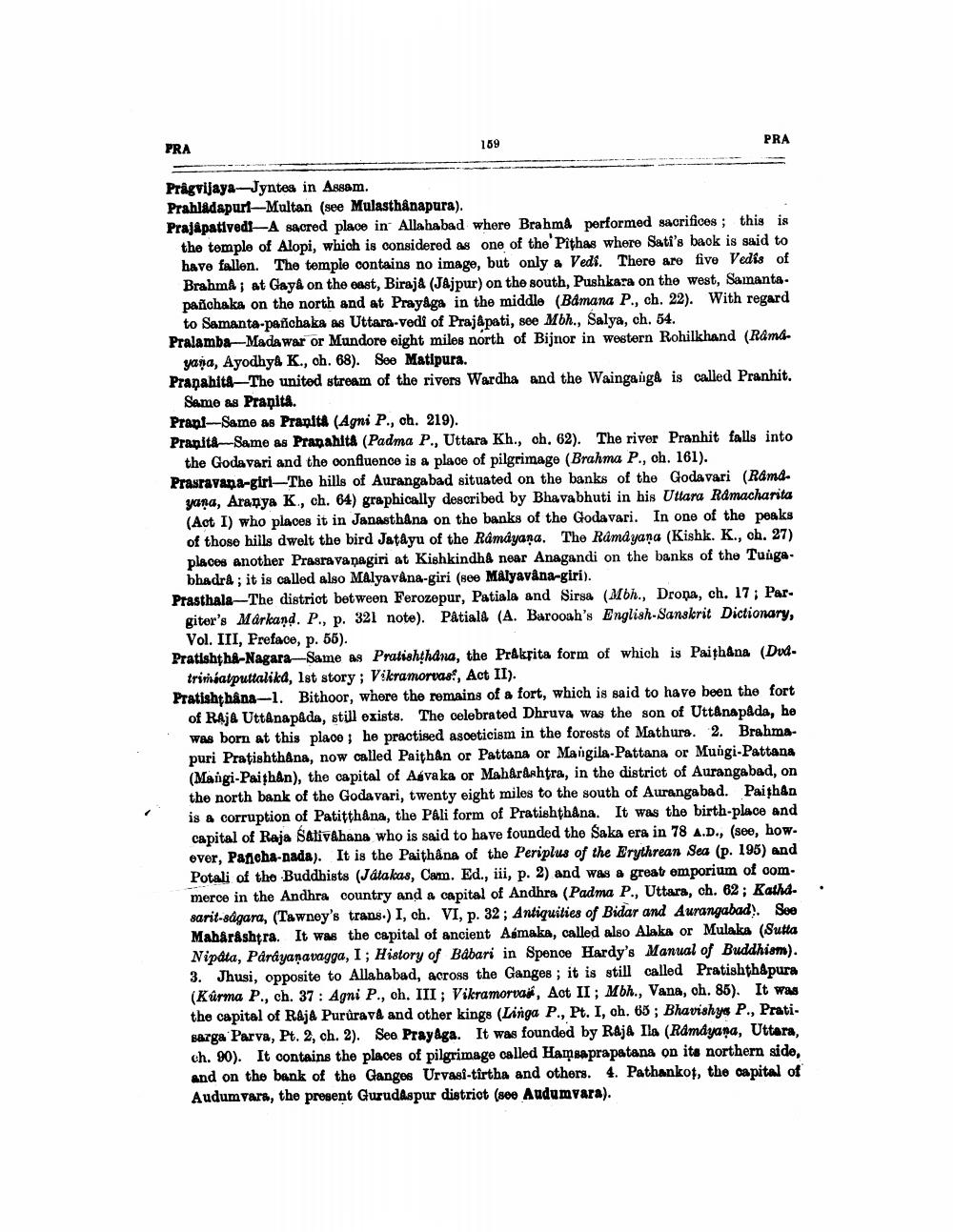________________
PRA
Pragvijaya-Jyntes in Assam.
Prahladapuri-Multan (see Mulasthanapura).
159
PRA
Prajapativedi-A sacred place in Allahabad where Brahmâ performed sacrifices; this is the temple of Alopi, which is considered as one of the Pithas where Sati's back is said to have fallen. The temple contains no image, but only a Vedi. There are five Vedis of Brahma; at Gayâ on the east, Biraja (Jajpur) on the south, Pushkara on the west, Samanta. pañchaka on the north and at Prayaga in the middle (Bamana P., ch. 22). With regard to Samanta-pañchaka as Uttara-vedi of Prajapati, see Mbh., Salya, ch. 54. Pralamba Mada war or Mundore eight miles north of Bijnor in western Rohilkhand (Râmâyana, Ayodhya K., ch. 68). See Matipura.
Prapahita-The united stream of the rivers Wardha and the Waingang is called Pranhit. Same as Pranita.
Prani-Same as Pranita (Agni P., ch. 219).
Pranita Same as Pranahita (Padma P., Uttara Kh., ch. 62). The river Pranhit falls into the Godavari and the confluence is a place of pilgrimage (Brahma P., ch. 161). Prasravana-girl-The hills of Aurangabad situated on the banks of the Godavari (Rama. yana, Aranya K., ch. 64) graphically described by Bhavabhuti in his Uttara Ramacharita (Act I) who places it in Janasthana on the banks of the Godavari. In one of the peaks of those hills dwelt the bird Jatayu of the Ramayana. The Ramayana (Kishk. K., ch. 27) places another Prasravanagiri at Kishkindhâ near Anagandi on the banks of the Tungabhadra; it is called also Malyavana-giri (see Malyavana-giri).
Prasthala-The district between Ferozepur, Patiala and Sirsa (Mbh., Drona, ch. 17; Pargiter's Markand. P., p. 321 note). Patiala (A. Barooah's English-Sanskrit Dictionary, Vol. III, Preface, p. 55). Pratishtha-Nagara-Same as Pratishthana, the Prakrita form of which is Paithana (Dvd
trimiatputtalika, 1st story; Vikramorvas, Act II).
Pratishthana-1. Bithoor, where the remains of a fort, which is said to have been the fort of Raja Uttanapada, still exists. The celebrated Dhruva was the son of Uttânapada, he was born at this place; he practised asceticism in the forests of Mathura. 2. Brahmapuri Pratishthana, now called Paithan or Pattana or Mangila-Pattana or Mungi-Pattana (Mangi-Paithan), the capital of Asvaka or Maharashtra, in the district of Aurangabad, on the north bank of the Godavari, twenty eight miles to the south of Aurangabad. Paithan is a corruption of Patitthâna, the Pâli form of Pratishthana. It was the birth-place and capital of Raja Salivahana who is said to have founded the Saka era in 78 A.D., (see, however, Pancha-nada). It is the Paithana of the Periplus of the Erythrean Sea (p. 195) and Potali of the Buddhists (Játakas, Cam. Ed., iii, p. 2) and was a great emporium of commerce in the Andhra country and a capital of Andhra (Padma P., Uttara, ch. 62; Kathasarit-sagara, (Tawney's trans.) I, ch. VI, p. 32; Antiquities of Bidar and Aurangabad. See Maharashtra. It was the capital of ancient Asmaka, called also Alaka or Mulaka (Sutta Nipata, Párayaṇavagga, I; History of Babari in Spence Hardy's Manual of Buddhism). 3. Jhusi, opposite to Allahabad, across the Ganges; it is still called Pratishthapura (Kurma P., ch. 37: Agni P., ch. III; Vikramorvas, Act II; Mbh., Vana, ch. 85). It was the capital of Raja Pururava and other kings (Linga P., Pt. I, oh. 65; Bhavishya P., Pratisarga Parva, Pt. 2, ch. 2). See Prayaga. It was founded by Raja Ila (Ramayana, Uttara, ch. 90). It contains the places of pilgrimage called Hamsaprapatana on its northern side, and on the bank of the Ganges Urvasi-tirtha and others. 4. Pathankot, the capital of Audumvars, the present Gurudaspur district (see Audumvara).




